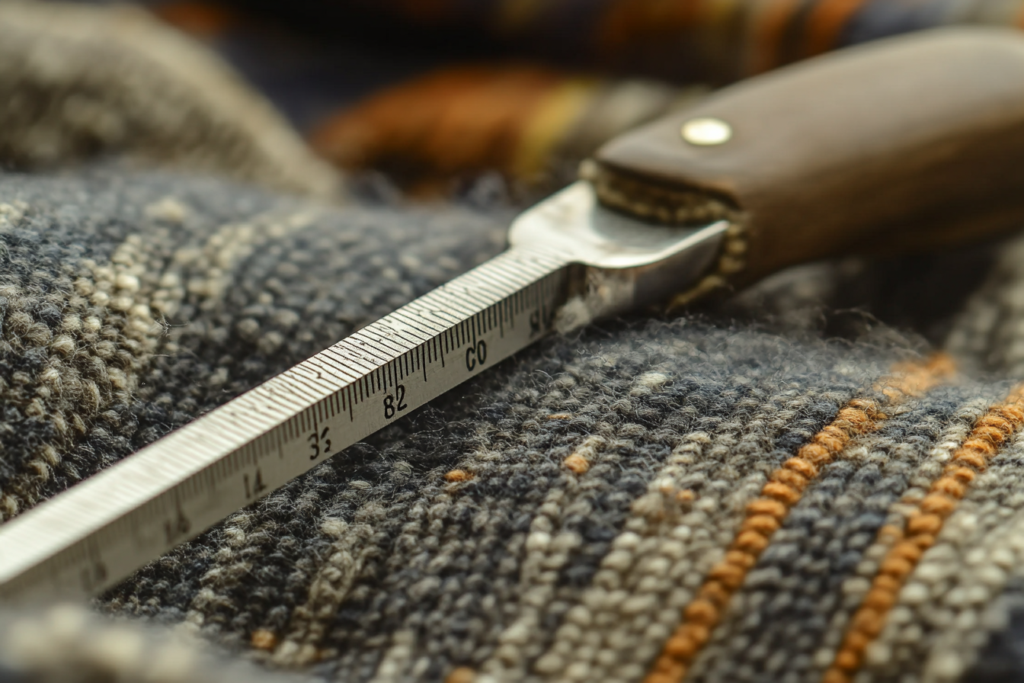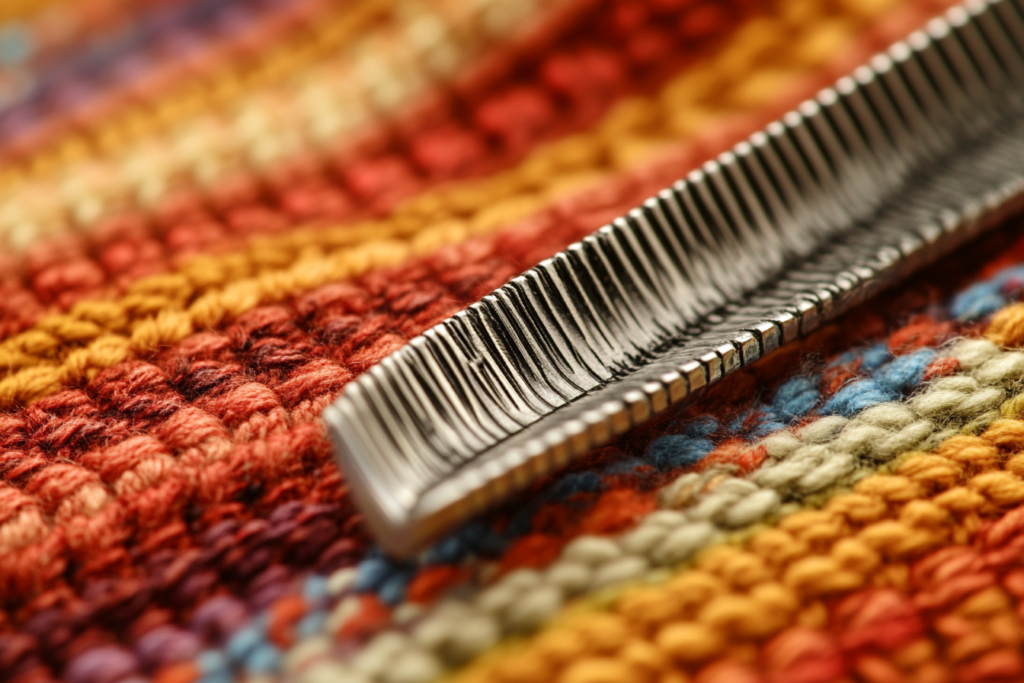Gauge or Cut of Wool Fabric: Understanding Stitches Per Inch in Knitwear and Sewing
Meta Description: Gauge or cut of wool fabric refers to the number of stitches per inch in knitwear and the spacing between seam rows in sewing. Learn how gauge affects fabric quality and design.
What is Gauge or Cut of Wool Fabric?
In knitwear and tailoring, the term gauge (also called “cut” in some cases) refers to the number of stitches per inch in a fabric. This measurement is crucial in determining the density, texture, and quality of knitted wool fabric, particularly in sweaters, trousers, and outerwear.
In sewing, gauge also refers to the distance between seam rows, which plays a key role in garment construction and finishing.
Whether used in knitwear production or sewing techniques, gauge is an important factor that influences fabric stretch, durability, and appearance.


Gauge in Knitwear: Stitches Per Inch
How is Gauge Measured?
In knitted wool fabrics, gauge is determined by counting the number of stitches per inch. A higher gauge means there are more stitches per inch, creating a finer and tighter knit, while a lower gauge results in a looser, chunkier knit.
Common Gauge Ranges in Knitwear
- Fine Gauge (High Gauge: 14-18 stitches per inch)
- Used for thin, lightweight sweaters and fine wool trousers.
- Creates a smooth, delicate texture suitable for formal wear.
- Commonly found in merino wool and cashmere sweaters.
- Mid Gauge (Medium Gauge: 7-13 stitches per inch)
- A balanced knit found in classic sweaters and cardigans.
- Suitable for casualwear, officewear, and mild winter clothing.
- Chunky Gauge (Low Gauge: 1-6 stitches per inch)
- Found in thick, warm knitwear, such as woolen sweaters, scarves, and coats.
- Provides a cozy, relaxed feel with an open-knit texture.
- Common in hand-knitted and winter garments.
Gauge in Sewing: Distance Between Seam Rows
In sewing terminology, gauge refers to the distance between seam rows, which can affect the durability, flexibility, and aesthetic appeal of a garment.
How Gauge Affects Sewing Construction
- Smaller seam gauge (closely spaced stitches)
- Provides stronger, more durable seams.
- Common in tailored trousers, suits, and fine wool garments.
- Larger seam gauge (wider stitch spacing)
- Used for decorative topstitching or looser-fitting garments.
- Often found in casualwear, knitwear, and denim.
In industrial sewing, different gauge measurements are used based on the fabric type and the garment’s function. High-tension areas like trousers’ waistbands or seams in wool coats often require smaller gauge stitching for added strength.
Why Does Gauge Matter in Wool Fabrics?
Gauge plays a significant role in both knitting and sewing, affecting how the fabric feels, drapes, and wears over time.
1. Fabric Density and Warmth
- A higher gauge (tighter knit) creates a denser, warmer fabric that retains heat better, making it ideal for winter garments.
- A lower gauge (looser knit) allows more airflow, making the fabric breathable and suitable for lightweight sweaters and transitional weather.
2. Stretch and Flexibility
- In knitwear, low-gauge fabrics are more stretchy and flexible, while high-gauge fabrics offer a more structured and fitted look.
- In sewing, a smaller seam gauge helps maintain structure, while a larger gauge can add ease and comfort.
3. Durability and Fabric Strength
- Tightly knit high-gauge wool is more durable and resistant to pilling, making it ideal for luxury sweaters and tailored suits.
- Loose-knit low-gauge wool may have a softer feel but is more prone to stretching or sagging over time.
Gauge vs. Ply: What’s the Difference?
Gauge is often confused with ply, but they refer to different aspects of knitting:
| Gauge (Stitches per Inch) | Ply (Number of Yarn Strands Twisted Together) |
|---|---|
| Refers to stitches per inch in knitted fabric. | Refers to the thickness of the yarn. |
| Determines the density and tightness of the knit. | Affects the bulkiness and weight of the fabric. |
| Higher gauge = finer knit (e.g., fine wool sweaters). | More plies = thicker yarn (e.g., chunky wool scarves). |
For example, a high-gauge, single-ply wool sweater will feel light and breathable, while a low-gauge, multi-ply wool sweater will feel thicker and heavier.
How to Choose the Right Gauge for Your Wool Garments
If you’re selecting a wool garment, consider the gauge based on your needs:
- For Lightweight, Breathable Sweaters → Choose a fine-gauge wool knit (14+ stitches per inch).
- For Classic, Everyday Wear → Opt for a mid-gauge wool knit (7-13 stitches per inch).
- For Warm, Chunky Knitwear → Select a low-gauge wool knit (1-6 stitches per inch).
For sewing wool fabric, ensure that gauge spacing in seams is appropriate for the garment type:
- Tailored wool trousers & suits → Smaller seam gauge for a precise fit.
- Casual wool sweaters & coats → Larger seam gauge for added comfort.
Conclusion: The Importance of Gauge in Knitwear and Sewing
Understanding gauge is essential for selecting the right wool fabric, whether for sweaters, trousers, or outerwear. Whether you’re working with high-gauge fine knits or low-gauge chunky wool, knowing how gauge impacts warmth, stretch, and durability helps in choosing the perfect garment.
In sewing, seam gauge spacing plays an important role in ensuring that wool garments fit well, maintain durability, and provide comfort. By considering stitches per inch, designers and consumers can make informed decisions about their wool garments’ quality and functionality.



